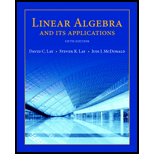
In Exercises 1 and 2, find the vector x determined by the given coordinate vector [x]B and the given basis B. Illustrate your answer with a figure, as in me solution of Practice Problem 2.
1. B =
Learn your wayIncludes step-by-step video

Chapter 2 Solutions
Linear Algebra and Its Applications (5th Edition)
Additional Math Textbook Solutions
Algebra and Trigonometry (6th Edition)
University Calculus: Early Transcendentals (4th Edition)
Calculus for Business, Economics, Life Sciences, and Social Sciences (14th Edition)
Elementary Statistics: Picturing the World (7th Edition)
- Find a basis for R2 that includes the vector (2,2).arrow_forwardPlease solvearrow_forwardIn a standard Cartesian coordinate system a vector, R, has an x-component of + 5.0 m and a y- component of - 4.0 meters. In the same coordinate system a vector F has an x-component of - 3.0 N and a y-component of 2.0 N. The cross product RxF is equal to 2.0 m*N in the + z direction 2.3 m*N in the - x direction 2.0 m*N in the - z direction 2.8 m*N in the + x direction 23 m*N in the - y directionarrow_forward
- please show work for problem 11 and justify answerarrow_forward15 Advanced Math 5. Calculate T.(₁). Te(₂). Te (73) in general. i.e. without assigning any value to the parameter t (so your answers should still contain {). Write your answer for each T, as one single vector, as it will help you in Question 6. By this, I mean if A = an a12] and 6- B then write 77 - A7 +5 as 7 (ED) - E [aux + a12y + b₁] [021 + a22y + b₂] (you can show 021 022] intermediate steps. of course!).arrow_forwardIf v + w = [ 5/1 ] and v - w = [ 1/5 ],compute and draw the vectors v and w.arrow_forward
- The following question is from linear algebra : Factors the vector (6, -5, -1)t into three components a,b,c that satisfy the following conditions: a depends on (2,0,1)t, b depends on (1,2, 0)t and c is orthogonal to a and b. Please show it step by step.arrow_forward1. Let (1,2) and 7: = (a) For which value of a the two vectors an are parallel? For which value of a they are orthogonal to each other? (b) For which value(s) of a the two vectors an 2. Consider the vectors (a) Is (b) Is = (3, a) be two vectors in R². Let = (1, 1, 1, 1) (1,2,3,0), = (0,1,2,3) and = (2,3,4,-3) a linear combination of a linear combination of are linearly independent? and ?? , and ?arrow_forward
 Linear Algebra: A Modern IntroductionAlgebraISBN:9781285463247Author:David PoolePublisher:Cengage LearningAlgebra & Trigonometry with Analytic GeometryAlgebraISBN:9781133382119Author:SwokowskiPublisher:Cengage
Linear Algebra: A Modern IntroductionAlgebraISBN:9781285463247Author:David PoolePublisher:Cengage LearningAlgebra & Trigonometry with Analytic GeometryAlgebraISBN:9781133382119Author:SwokowskiPublisher:Cengage Elementary Linear Algebra (MindTap Course List)AlgebraISBN:9781305658004Author:Ron LarsonPublisher:Cengage Learning
Elementary Linear Algebra (MindTap Course List)AlgebraISBN:9781305658004Author:Ron LarsonPublisher:Cengage Learning


